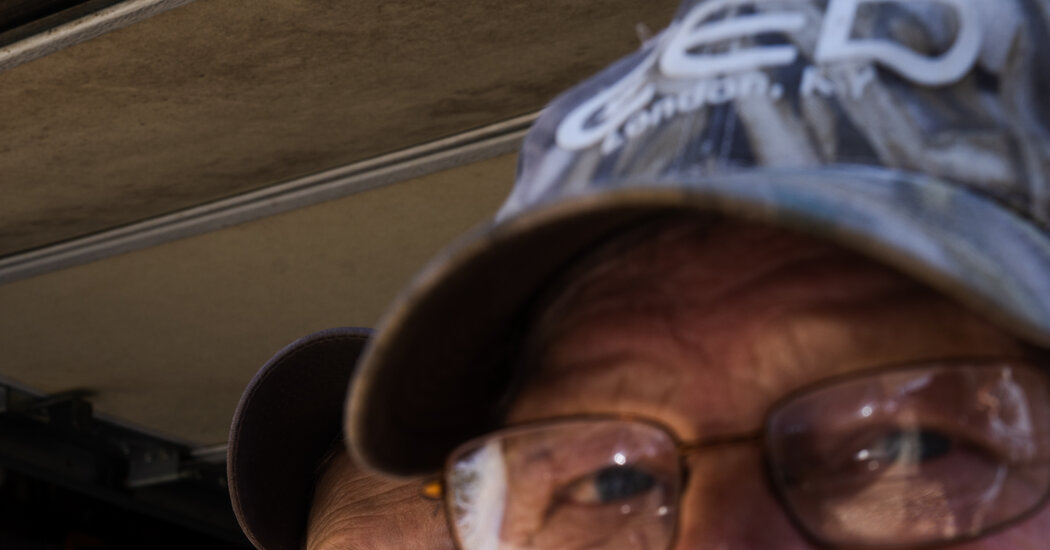Denver Brock and his son Aundra used to spend early mornings hunting rabbits in the wooded highlands of Harlan County, Ky. But they don’t get out there much these days. They both get too breathless trying to follow the baying hounds.
Instead, they tend a large garden alongside Denver Brock’s home. Even that can prove difficult, requiring them to work slowly and take frequent breaks.
“You get so dizzy,” Denver Brock said, “you can’t hardly stand up.”
The Brocks followed a long family tradition when they became Appalachian coal miners. For it, they both now have coal workers’ pneumoconiosis, a debilitating disease characterized by masses and scarred tissue in the chest, and better known by its colloquial name: black lung.
Mr. Brock, 73, wasn’t all that surprised when he was diagnosed in his mid-60s. In coal mining communities, black lung has long been considered an “old man’s disease,” one to be almost expected after enough years underground.
But his son was diagnosed much younger, at just 41. Like his father, he has progressive massive fibrosis, the most severe form of the disease. And today, at 48, he’s even sicker.
When he followed his father into mining, he thought he was entering a safer industry than the one prior generations had worked in. By the 1990s, safety standards and miner protections had nearly consigned the disease to history.
But now, black lung is back.
Modern miners are contracting it at younger ages and at rates not seen since the 1970s. For 20th-century miners, it could take decades to develop severe black lung. For men of Aundra Brock’s generation, just a few years can be enough. Nationwide, one in 10 working miners is now estimated to have black lung. In the heart of the central Appalachian coal fields, it’s one in five. Often, their disease is more severe, the progression faster. Doctors are seeing larger masses and more scarring in the lungs. Transplants, disability claims and deaths are all on the rise.
In an old industry, the reasons are modern. Centuries of extraction have altered the landscape, making the mountains more dangerous to mine, researchers say, and the men beneath them vulnerable not just to black lung, but to another lung disease called silicosis.
Experts say it should be possible to reverse the trend. “The entire thing about this whole disease is it’s 100 percent preventable,” said Dr. Robert Cohen, a pulmonologist at the University of Illinois Chicago who has studied the disease for decades. “It’s not an act of God or an act of nature. It’s not something out of our control. In a wealthy country with a wealthy economy, we should be able to do better.”
From an industry perspective, miner health and safety “is always an area that can be improved,” said Ashley Burke, a spokeswoman for the National Mining Association, which represents more than 250 companies. Ms. Burke said the association has supported mandatory screenings, research into technologies that could protect miners and an expedited government approval process for new equipment.
But as President Trump aims to revitalize the mining industry, doctors and researchers like Dr. Cohen also worry that federal government cuts are hampering efforts to find a solution.
A Shocking Revelation
When Dr. Brandon Crum, 50, opened his radiology clinic in Coal Run Village, Ky., in 2013, he didn’t expect to encounter many grave cases of black lung.
Rates had fallen in the years after Congress passed the Coal Mine Health and Safety Act of 1969, which put limitations on acceptable levels of dust and established a federal program for black lung benefits. During the 1990s, the government documented only a few dozen cases, a low number even when accounting for the steep decline in mining jobs. Progressive massive fibrosis, the type of black lung the Brocks have, was nearly eradicated.
Dr. Crum, a Kentucky native, was well aware of the trends. Before attending medical school, he had worked at his family’s mine as a teenager until the coal reserves ran out.
But quickly, Dr. Crum began seeing a shocking amount of progressive massive fibrosis: 60 cases over about 18 months. And the patients were often younger. One was just 44.
Progressive massive fibrosis occurs when dust settles in the lungs, and over time the resulting inflammation turns to hardened tissue. Eventually, patients can’t get enough air to allow them to climb a set of stairs or carry groceries. Trying to eat, tying their shoes or taking a shower leaves them short of breath. Coughing can bring up mucus that might be black or bloody.
Medication can sometimes slow the disease’s progression, but there is no cure. Hearts fail. People can struggle to breathe as their chests fill with fluid, a slow death by suffocation. By the time the lungs are examined at autopsy, they are often the color of coal.
In 2016, Dr. Crum attended a black lung conference in West Virginia in hopes of speaking to Scott Laney, an epidemiologist at the National Institute for Occupational Safety and Health and the chief scientist of the institute’s health surveillance program for coal workers. Dr. Crum explained what he was seeing, but Dr. Laney was skeptical.
“I said, ‘Slow down, cowboy,’” Dr. Laney said. “People call my desk every day and say, ‘I’ve got this, I’ve got that,’ and we investigate, and it’s nothing.”
But Dr. Crum was persuasive enough that Dr. Laney agreed to travel to the clinic in Coal Run from his home in Morgantown, W.Va. There, Dr. Laney viewed one X-ray after another of the worst black lung he had ever seen.
“I was sick to my stomach,” he said. “I could not believe my eyes.”
Around the same time, Dr. Cohen, the pulmonologist, noticed something was amiss, too. Since the late 1980s, Dr. Cohen’s work has focused on mining safety issues. He watched as rates of black lung plunged, which was why he was so surprised when clinics began sending him a number of severe cases to review.
When Dr. Cohen and his colleagues analyzed the lung tissue of 13 miners from West Virginia, Kentucky and Pennsylvania, they were alarmed to find that only one had a classic coal-based form of black lung. The others all had a form of silicosis, a lung disease more closely associated with stonecutters.
Silicosis is caused by inhaling a mineral called crystalline silica that is typically found in sand, stone and concrete. It is a building block of the Appalachians. But in the air, it is dangerous, able to create much worse scarring in the lungs than coal dust alone. Breathing the coal and silica dust together can create a kind of hybrid disease that quickly leads to progressive massive fibrosis.
Scientists and miners alike have long understood the dangers of the rock dust. “You can tell there’s silica when you see the flicker in it,” said Charles Thacker, a 69-year-old former miner from Norton, Va., who now has black lung. “It looks like bits of glass flashing in the light. It’s almost pretty. But that’s what gets in your lungs and cuts you up.”
For that reason, in 1974, the occupational health institute tried to limit miners’ exposure to silica by recommending mine operators ensure that their workers weren’t breathing more than 50 micrograms of silica per cubic meter of air. Instead, regulators set the exposure limit twice as high, where it remained for half a century.
Through further research, Dr. Cohen’s group and others repeatedly showed that miners’ lungs were filling with more silica than before. There were a number of factors that were likely to have increased silica exposure, including longer hours in the mines and the advent of powerful modern machinery that created finer silica dust that could easily penetrate the lungs.
But the experts settled on one reason as the most likely: Back when Denver Brock’s career began in 1969, it was typical to be working along an underground wall of coal that reached above a miner’s head. Today, many of those large coal deposits have been mined out of central Appalachia. The coal that remains is encased in thick layers of quartz and sandstone. Contemporary miners have to get through more rock, and when they drill, cut and blast it apart, that rock turns to dangerous crystalline silica dust, which is exactly what doctors found in Aundra Brock’s lungs.
Legal Fights, X-rays and Dashed Dreams
St. Charles, Va., is a hollowed-out place. Boarded-up buildings loom alongside the road. Wedged between the creek and the railroad tracks sits a former hardware store that now houses the nation’s largest federally funded black lung clinic.
After seeing the case files collected by Dr. Crum, Dr. Laney’s team reached out to a network of federally funded black lung clinics, looking for more evidence of a growing problem. Within 48 hours, Stone Mountain Health Services, which runs the clinic, had gotten in touch. Here, federal investigators documented 416 additional cases, many in men who had first felt sick in their 30s and 40s.
At the University of Virginia, Dr. Drew Harris, a pulmonologist, read the report and wanted to help. Now, once a month, he drives the 300-plus miles from his office in Charlottesville, Va., to see patients who have black lung — or might soon.
The time he spends in St. Charles is packed with appointments. He’s the only pulmonologist for Stone Mountain Health Services, which runs two black lung clinics in southwest Virginia. His patients, including Mr. Thacker and the Brocks, often drive more than an hour to see him.
Dr. Harris administers breathing tests and looks over CT scans to monitor disease progression in established patients, the sickest of whom arrive with portable oxygen units. Miners who have come for an initial exam — the first step in the process to prove they have black lung and are owed benefits — get an X-ray and a breathing test and then climb on a treadmill or an exercise bike to determine their blood oxygen level.
Dr. Harris’s desire to do this work makes him a rarity. Many are unwilling to get involved, because treating the disease often requires wading into the complex and contentious benefit system. When miners are deemed eligible, one of their former employers, not the government, typically provides a monthly stipend and covers the cost of treatment. Coal companies often fight a decision that doesn’t go their way, and doctors frequently have to go through depositions.
The legal fights can take years and prove arduous. Mr. Brock had to appeal his own case after being initially denied federal benefits, and it was years before he saw any money. Still, Denver Brock said he loved mining and would do it all again. His son would still be mining, too, if he were able. When Aundra Brock finished high school, he wanted to be a husband and a homeowner. His mining salary soon paid for a tidy house in a quiet hollow, just across the road from his parents.
But today, the masses in the younger Mr. Brock’s lungs have grown so large that his doctors have begun talking about a lung transplant. Even if he gets one, and the risky procedure goes well, many black lung patients live for only a few more years. Aundra Brock is resistant. Two of his own friends had the surgery and died not long afterward, he said.
Ms. Burke of the National Mining Association said that work conditions had improved over the last decade but that the benefits had yet to be reflected in the disease data, arguing that they could take 10 years to become clear. She said strict adherence to ventilation plans and compliance with a 2014 rule that lowered the acceptable amount of airborne dust had reduced dust levels.
But more than a decade out from the rule’s implementation, Dr. Laney said he had been seeing more black lung, not less.
“You don’t get 30- and 40-something-year-old men on bilateral lung transplant evaluations if they aren’t breathing toxic dust,” Dr. Laney said. And increasingly, he added, he is concerned “that young men entering the work force as coal miners will not have the same health system afforded them that their dads and their dads’ dads had.”
Federal Cuts and Rule Delays
On April 1, more than 800 people at the National Institute for Occupational Safety and Health, including Dr. Laney, received notices that their jobs had been eliminated as part of broader federal cuts. After a federal judge issued an injunction, Dr. Laney and others in the coal workers’ health surveillance program got their jobs back. But many other government scientists focused on solving the black lung problem did not.
Among them was the entire Pittsburgh mining research division. The division had been developing technology to monitor silica dust exposure in real time, potentially preventing miners from getting sick in the first place. “These cuts are going to endanger and kill miners in this country,” said Brendan Demich, an engineer at the Pittsburgh division who represents his government colleagues as vice president of their union.
Emily Hilliard, a spokeswoman for the U.S. Department of Health and Human Services, said in a statement that the most essential services for miners would continue despite cuts at the department. “Ensuring the health and safety of our work force remains a top priority for the department,” Ms. Hilliard said.
But the cuts have had a ripple effect. For more than a decade, an agency within the Department of Labor, the Mine Safety and Health Administration, had been using the occupational health institute’s data, as well as the research of Dr. Cohen and others, to develop a case for lowering the silica exposure threshold. Last year, the agency finally issued a new standard, reducing the limit to the 50 micrograms that was recommended decades ago. It was set to go into effect this April.
But in the wake of “unforeseen NIOSH restructuring,” the agency announced it would pause implementation of the rule. The announcement came less than a week before enforcement was set to begin, and on the same day Mr. Trump signed executive orders aimed at bolstering what he called the “beautiful clean coal industry.”
Even if every coal operation in central Appalachia closed tomorrow, Dr. Crum said, miners who have taken in enough of the toxic mix of silica and coal dust would need decades of care. “Then they’ll die,” he said, “and we’ll have a lot more widows and children and grandchildren whose fathers were taken much earlier than they should have been.”
One of those widows is likely to be Denver Brock’s 67-year-old wife, Loretta. A coal miner’s daughter, she can now only watch as the health of both her husband and her son deteriorates. The breaks in the garden are longer now. On cold days, the men can barely step outside without their lungs burning.
“It’s hard to watch,” Ms. Brock said. “It takes a lot of prayer to get through this.”
Audio produced by Sarah Diamond.
Read by Kate Morgan
Kate Morgan is a journalist in central Pennsylvania and a media fellow at The Nova Institute for Health.
The post In Appalachia, a Father Got Black Lung. Then His Son Did, Too. appeared first on New York Times.




